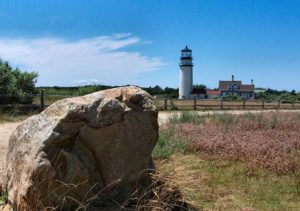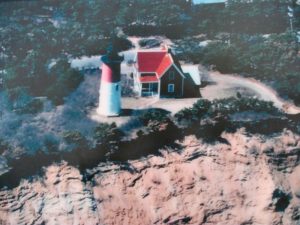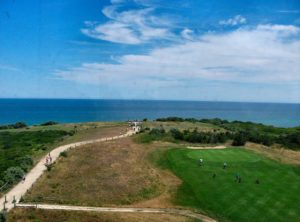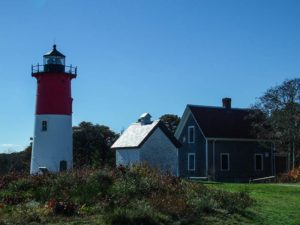Lighthouses are beacons dotting the coastlines of most waterways across the globe. These structures are built with the purpose of protecting and guiding vessels passing through the nearby waters. Dating back to the 5th century B.C. and a simple stone tower with a fire beacon in Piraeus Harbor in Athens, Greece lighthouses have been saving lives for thousands of years. However these landmarks are not immortal. The dangerous seas which they watch over can often claim the land upon which the lighthouse stands.
On Cape Cod erosion and shoreline change are a part of daily life. It has affected countless beaches and other coastal properties. This includes lighthouses. This can end up with the structures being moved away from eroding cliffs in a long and arduous journey. Gay Head Lighthouse in the town of Aquinnah on Martha’s Vineyard was the most recent endangered beacon which needed to be moved in 2015. Though a relative rarity on Cape Cod did you know that two of the Cape’s beloved lighthouses were moved within months of each other in 1996?
Highland Lighthouse in Truro is the oldest light station on Cape Cod with the original structure having been built in 1797. The current tower, once visited by Henry David Thoreau, was constructed in 1857 and sits alongside the Highland Links Golf Course, also the oldest on Cape Cod. The original lighthouse when built stood 500 feet from the edge of a 125-foot tall cliff. By the early 1990’s though Highland Light stood just over one hundred feet from the cliff.
Nauset Lighthouse in Eastham began its life thirteen miles to the south as its initial incarnation was as one of the Chatham Twin Lights. The Nauset Light Station however was created in 1838 with three fifteen-foot tall brick beacons dotting the cliff nicknamed the Three Sisters. In 1892, due to the creeping erosion, the brick towers were replaced with wooden towers standing twenty-two feet tall. By 1911 the cliffs had eroded enough that the wooden lights had to be moved. Two of the three ‘sisters’ were sold at auction to Helen Cummings for use as part of a summer home. The third tower was moved back and put on a brick foundation. It would be retired in 1923 and replaced by one of the cast iron Chatham Twin Lights. Renamed Nauset Lighthouse it would receive its red and white color in 1940. In 1993 with the cliffs again creeping in the Coast Guard suggested decommissioning the lighthouse. Hundreds of letters would pour in asking that the light be moved inland to safety. This led to the creation of the Nauset Light Preservation Society in 1993.
The stories of these two lighthouses located thirteen miles apart became intertwined in 1996 when the sands of time literally began running out on the chance to save the historic beacons.

A view of Highland Light with the marker where the lighthouse once stood in the foreground. Christopher Setterlund photo.
Highland Light would be the first to be moved. The Truro Historical Society would raise funds along with $1 million in federal funds and $500,000 in state funds to help aid in the lighthouse’s move. A contract was signed with the International Chimney Company of Buffalo, New York along with Expert House Movers of Maryland. The eighteen day move took place in June 1996 with the lighthouse being raised and set on rails. It was moved 450-feet west from its original location, between the 7th and 8th holes of Highland Links. A stone marker was placed on the ground where the center of the lighthouse once stood. After its move closer to Highland Links an errant golf ball actually broke a pane of glass in the lantern room; unbreakable panes were installed shortly thereafter.
Nauset Light would be moved second. In late-September 1996 a contract was signed between the Nauset Light Preservation Society and the same International Chimney Company which moved Highland Light. The move was happening just in time as after Hurricane Edouard passed by the Cape during the first week of September Nauset Light sat a precarious thirty-six feet from the edge of the cliffs. The company needed a minimum of thirty-feet to maneuver the equipment around the lighthouse. The lighthouse would be moved in one piece 336-feet southwest of its original site. The move took two days beginning November 15, 1996. In a testament to the relentless encroachment of the sea it is estimated by the Nauset Light Preservation Society that despite the move the lighthouse might only be safe for another thirty years before another move might need to be planned.
For the time being though both iconic beacons are safely tucked away from the ocean’s grasp.
By Christopher Setterlund


























